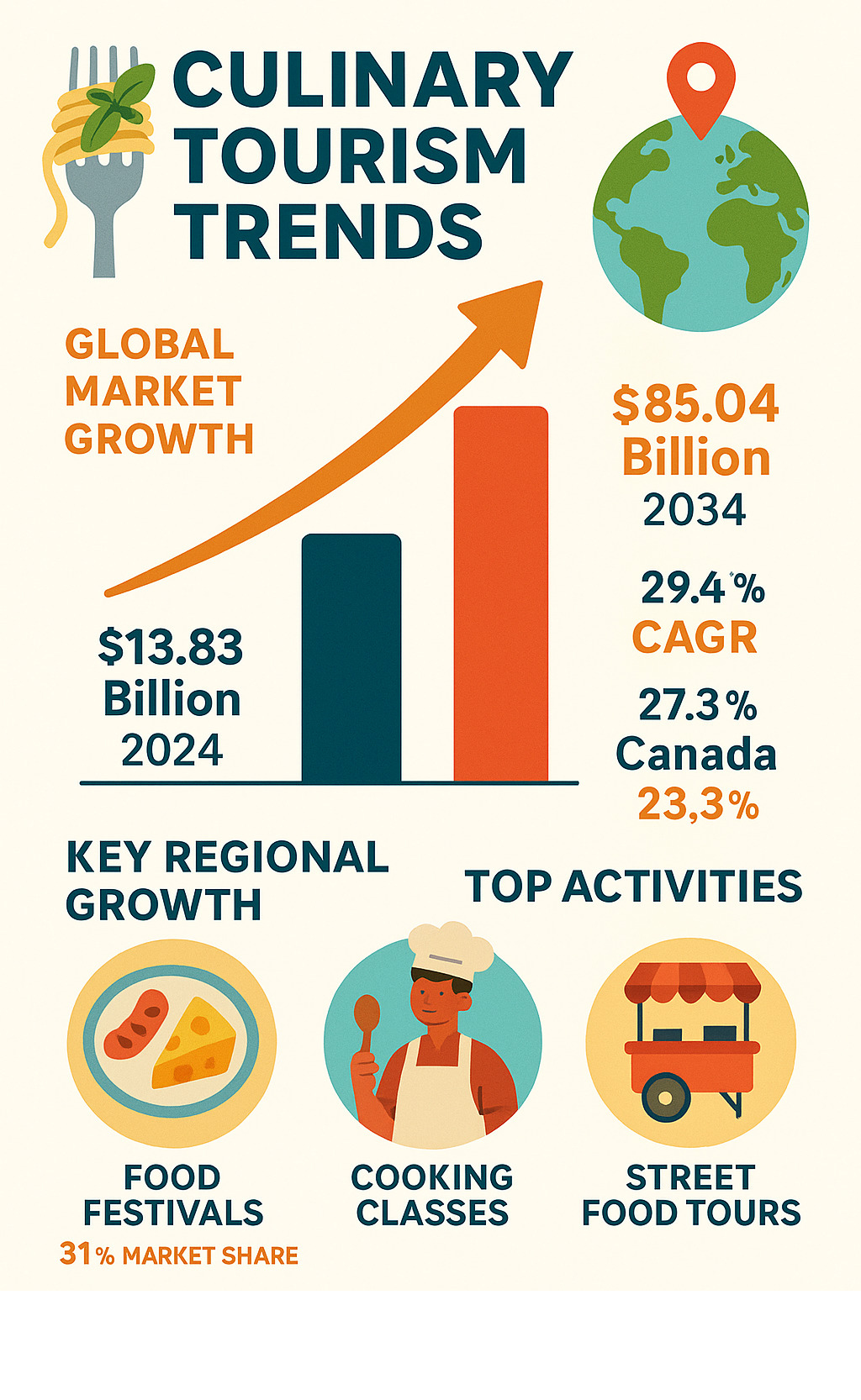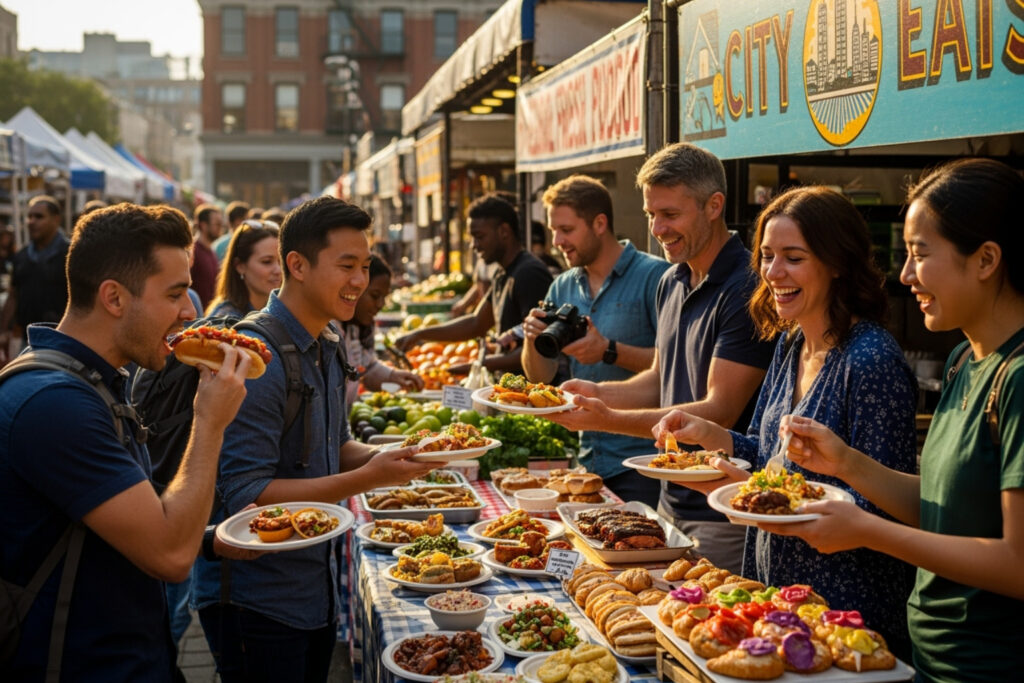Why Culinary Tourism is Revolutionizing Modern Travel
Culinary tourism trends are reshaping how we explore the world, with food experiences now driving destination choices more than ever before. What started as a simple desire to try local dishes has evolved into the fastest-growing segment in luxury tourism, fundamentally changing travel priorities and spending habits.
Key Culinary Tourism Trends:
- Market explosion: Global culinary tourism market projected to reach $85.04 billion by 2034 (19.92% CAGR)
- Experience-first travel: 88% of travelers rank finding new food trips as “important” or “very important”
- Booking behavior shift: Half of travelers now book restaurant reservations before securing flights
- Hyperlocal dining: Focus on farm-to-table, heritage ingredients, and zero-waste kitchens
- Immersive experiences: Cooking classes, street food tours, and home dining with locals
- Wellness integration: “Food as medicine” trend combining nutrition with travel
- Tech improvement: AI-personalized culinary itineraries and virtual food experiences
In 2025, the journey truly is as much about the plate as the place. This shift reflects a deeper desire for authentic cultural connection. Food serves as a universal language, with 83% of travelers believing it creates lasting positive impressions of a destination and 81% saying it helps them understand local culture. From New York’s diverse culinary scene to New Orleans’ distinctive Creole heritage, food has become the primary lens through which modern travelers connect with new places.

Culinary tourism trends word roundup:
The Exploding Appetite for Food Travel: Market Growth and Key Drivers
The appetite for food travel is exploding, driven by several key factors. Culinary tourism trends show that social media influence turns beautifully plated dishes into travel inspiration, while the popularity of food television lifts chefs and regional cuisines to must-try status. More fundamentally, modern travelers crave authentic experiences, and food serves as the perfect bridge to local culture. As disposable income increases globally, more people can prioritize these meaningful culinary journeys, seeking the real story of a place on their plate.
For a deeper dive into this change, explore How Food Tourism is Changing the Way We Travel.
Why Food is the New Destination
Food is now the destination for many. The traveler decision-making process has shifted, with many booking restaurants before flights and nearly one in five planning trips specifically for culinary experiences. This extends to accommodation, with 60% of luxury travelers choosing hotels based on their restaurant quality. The economic impact on local communities is substantial, as food experiences can account for up to 35% of a travel budget, directly supporting local farmers, artisans, and restaurateurs.
The Modern Food Traveler
The modern food traveler is diverse. Existential tourists (41% market share) seek authentic food in genuine local settings, like historic Creole restaurants in New Orleans or neighborhood diners in New York. In contrast, diversionary tourists prefer top-rated, refined experiences. The appeal spans generations, with Gen Z, Millennials, and Baby Boomers all budgeting significantly for food travel. A telling statistic reveals their commitment: 82% of travelers spend more on food and beverages while traveling than at home, cementing food’s central role in the travel experience.
For those ready to explore authentic local flavors, our Authentic Local Food Guides offer insider insights into finding the best local culinary experiences.
Decoding the Plate: Key Culinary Tourism Trends for 2025 and Beyond
The landscape of food travel is shifting. As we look to 2025 and beyond, culinary tourism trends point toward experiences that offer deeper connections. Today’s food travelers seek stories, community connections, and nourishment for both body and soul through experiential dining. Key drivers include sustainability, as travelers choose destinations based on environmental responsibility, and technology, which personalizes culinary exploration. A growing wellness focus also sees travelers viewing food as medicine, seeking out destinations known for nutritious cuisine.
This evolution represents The Rise of Experiential Dining – a movement that’s changing how we think about food, travel, and connection.
Hyperlocal and Sustainable Dining: A Core Culinary Tourism Trend
A key shift in culinary tourism trends is the move toward hyperlocal and sustainable dining. The farm-to-table movement is now an expectation, with travelers in destinations like New Orleans and Texas seeking restaurants that support regional food systems. This interest extends to foraging tours, zero-waste kitchens that showcase creativity, and the revival of ancient culinary techniques like wood-fired cooking. Diners are also seeking out heritage ingredients—heirloom varieties and native plants that offer a true taste of a region’s agricultural history.
This commitment to local and sustainable practices aligns perfectly with responsible travel values. For deeper insights into this movement, explore our resources on Sustainable Food Tourism and find Why Locally Sourced Ingredients Make a Difference.
Immersive Experiences Over Reservations
Today’s food travelers are hungry for active participation. Cooking classes remain the gold standard, allowing travelers to learn authentic recipes in a hands-on setting. Street food tours are beloved for the authentic tastes and cultural insights they offer, whether in New York or New Orleans. Food festivals (31% market share) offer a concentrated taste of local specialties, while wine and spirit tastings provide deep dives into regional beverage traditions. Perhaps the most intimate experience is home dining with locals, an increasingly popular trend that offers an unfiltered glimpse into daily life and family traditions.
Our Local Cooking Classes and Street Food Tours showcase some of the most authentic opportunities available.
Emerging Culinary Tourism Trends: From Wellness to Tech
The future of food travel is being shaped by wellness and technology. The ‘food as medicine’ movement has given rise to wellness-focused culinary retreats that combine nutritious eating with rejuvenating activities. On the tech side, AI-personalized travel itineraries are revolutionizing trip planning by suggesting experiences based on individual tastes and dietary needs. Virtual reality food experiences offer previews of destinations, while other innovative dining experiences use technology like NFC to provide diners with detailed information about their meals, creating new ways to interact with food.
For the latest insights into these evolving trends, explore our comprehensive guide to Culinary Travel Trends and find how technology and wellness are reshaping the future of food travel.
American Culinary Hotspots: Where to Find the Best Food Trips

The United States is home to some of the world’s most dynamic culinary destinations, each offering a unique taste of American culture. When we explore culinary tourism trends, certain cities consistently rise to the top. The power of culinary recognition is immense; when the Michelin Guide arrived in Atlanta, for example, featured restaurants saw a 30% business increase in the first year. This highlights how destinations like New York, New Orleans, and Texas have become magnets for food travelers.
For those planning their next food-focused trip, our Best Food Tourism Destinations guide offers insider insights into the world’s most compelling culinary hotspots.
New York: The Global Culinary Capital
As a true melting pot, New York City’s food scene is a world tour on a plate. The city continues to earn new Michelin stars, showcasing everything from high-end fine dining to iconic street food like pizza and bagels. For food travelers, New York offers an unparalleled density of diverse, world-class culinary experiences, making it a perennial favorite.
New Orleans: A Taste of Creole and Cajun Heritage
New Orleans offers a culinary identity unlike any other, deeply rooted in its unique blend of Cajun and Creole traditions. From beignets in the French Quarter to gumbo in a family-run bistro, the city’s food tells the story of its rich history. This distinctive heritage makes New Orleans a must-visit destination for anyone seeking authentic American flavors.
Texas: Barbecue, Tex-Mex, and Beyond
Texas presents a bold and flavorful culinary landscape, famous for its legendary barbecue and vibrant Tex-Mex cuisine. Cities like Austin and Houston are epicenters of food innovation, where traditional smokehouses thrive alongside modern, chef-driven restaurants. The state’s distinct food culture offers a rich and satisfying journey for any culinary tourist.
The Broader Impact: How Food Tourism Shapes Culture and Economies
Culinary tourism trends create ripple effects that build bridges between cultures and communities. The impact is profound. Culturally, it fosters understanding, with 81% of travelers reporting that food experiences help them connect with local culture. Economically, it empowers communities by creating a web of opportunity for farmers, artisans, and family restaurants. The job creation potential is significant, especially in places like New Orleans where food culture is central.
However, this growth brings challenges like overtourism, which can crowd local spots and strain communities. Preserving authenticity is a delicate balance, as there’s a risk of altering traditions to suit tourist tastes. Responsible travel choices are key to ensuring these experiences remain genuine and beneficial for the host communities.
At The Dining Destination, we believe in guiding food enthusiasts toward experiences that celebrate and support local communities. Understanding Local Food Culture helps us make choices that benefit everyone involved in the culinary ecosystem.
Challenges and Opportunities
The growth in culinary tourism trends presents a dance between tradition and change. The tension between globalization and local identity threatens unique regional flavors. Managing tourist influx is crucial to prevent popular destinations from becoming victims of their own success, overwhelming local infrastructure and residents.
Yet, these challenges create tremendous opportunities for small businesses. Family-run restaurants and local producers can thrive when travelers seek authenticity. Culinary tourism can also promote lesser-known destinations, shining a spotlight on hidden gems and distributing economic benefits more widely. Government tourism boards are increasingly recognizing this, launching culinary trails and festivals that celebrate regional heritage. The key is sustainable growth that empowers local communities, making travel a powerful tool for cultural preservation and economic development.
Frequently Asked Questions about Culinary Tourism Trends
What is the definition of culinary tourism?
Culinary tourism, also known as food tourism or gastronomy tourism, is beautifully defined as “traveling for a taste of place in order to get a sense of place.” It’s much more than just eating while you travel – it’s about diving deep into a destination’s soul through its flavors.
When you start on culinary tourism, you’re experiencing the food and drink of a particular region as your primary window into local culture, history, and traditions. This might happen through guided food tours that take you through busy markets, hands-on cooking classes where you learn family recipes passed down through generations, vibrant food festivals that celebrate seasonal harvests, or even independent exploration where you follow your nose to hidden gems.
What makes culinary tourism trends so powerful is that food becomes your cultural translator. Every bite tells a story – whether it’s understanding why New Orleans developed its unique Creole flavors or finding how Texas barbecue reflects the state’s ranching heritage. It’s about using cuisine as your primary means of cultural immersion and findy.
What is the fastest-growing segment in luxury travel?
The answer might surprise you with its deliciousness: culinary travel and food-related experiences have claimed the crown as the fastest-growing segment within the luxury tourism industry. This isn’t just a small trend – it’s a complete change of how affluent travelers choose to spend their vacation time and budgets.
What’s driving this hunger for gourmet experiences? Luxury travelers are increasingly prioritizing unique dining experiences, gourmet trips, and authentic culinary immersion as key motivators when deciding where to go next. They’re booking tables at destination restaurants before they even secure their flights!
The numbers tell an impressive story: food tourism is projected to grow at a CAGR of 7.6% between 2024 and 2030 in the luxury segment alone. However, when we look at culinary tourism trends more broadly, some projections show even higher growth rates for the entire market. This means that whether you’re seeking a Michelin-starred meal in New York or an authentic cooking class in a family kitchen, culinary experiences are becoming the ultimate luxury.
How does culinary recognition affect tourism in a region?
The impact of prestigious culinary recognition on a destination is nothing short of transformative. When organizations like the Michelin Guide decide to spotlight a city or region, it’s like turning on a powerful guide that attracts food lovers from around the globe.
Take Atlanta as a perfect example: the city experienced a remarkable 30% business increase at the 45 restaurants featured in the Michelin Guide during just the first year of recognition. That’s not just a small boost – that’s a game-changing economic impact that ripples through the entire community.
This type of culinary recognition creates a powerful cycle of growth. It attracts international food travelers who are specifically seeking out these acclaimed experiences, increases business for the recognized restaurants and their surrounding establishments, and lifts the destination’s global culinary reputation in ways that traditional tourism marketing simply can’t match.
The broader economic benefits are substantial and long-lasting. We see increased visitor spending as food tourists typically allocate larger portions of their budgets to dining experiences, job creation in restaurants, hotels, and related service industries, and improved local pride as communities see their culinary traditions celebrated on an international stage.
What’s particularly exciting about culinary tourism trends is how this recognition transforms entire regions into desirable culinary destinations, creating opportunities for small local producers, family restaurants, and artisanal food makers to thrive alongside the acclaimed establishments.
Conclusion
As we wrap up our exploration of culinary tourism trends, it’s clear that food has become far more than just fuel for our travels—it’s the very compass guiding our trips. What started as simply trying local dishes has transformed into the fastest-growing segment of luxury travel, creating a beautiful bridge between cultures and communities worldwide.
The numbers tell an incredible story. From a market worth $13.83 billion in 2024 to a projected $85.04 billion by 2034, we’re witnessing a culinary revolution that’s reshaping how we think about travel. Whether you’re drawn to the hyperlocal farm-to-table movement, fascinated by ancient culinary techniques, or excited about AI-personalized food itineraries, there’s never been a more delicious time to explore the world.
We’ve journeyed through Europe’s enduring gastronomic legacy, finded Asia-Pacific’s explosive growth, and savored the authentic flavors of the Americas. From New York’s dynamic Michelin-starred scene to New Orleans’ soulful Creole traditions, each destination offers its own unique story told through taste.
The future of food-focused travel promises even more exciting developments. Sustainability isn’t just a trend—it’s becoming the foundation of responsible culinary exploration. Technology is personalizing our food journeys in ways we never imagined, while wellness-focused culinary retreats are nourishing both body and soul.
At The Dining Destination, we’re passionate about guiding you through this incredible culinary landscape. We believe in the power of mindful exploration, where every meal becomes a meaningful connection with local culture and community. When you choose authentic experiences over tourist traps, you’re not just feeding yourself—you’re supporting local farmers, artisans, and families who keep these culinary traditions alive.
The world is your oyster (or should we say, your perfectly plated farm-to-table dish?). Whether you’re planning your first food-focused trip or you’re a seasoned culinary explorer, the best journeys happen when we approach them with curiosity, respect, and an open heart—and an empty stomach.
Ready to start on your next gastronomic trip? Explore our guides to the world’s best restaurants and let your taste buds lead the way.









